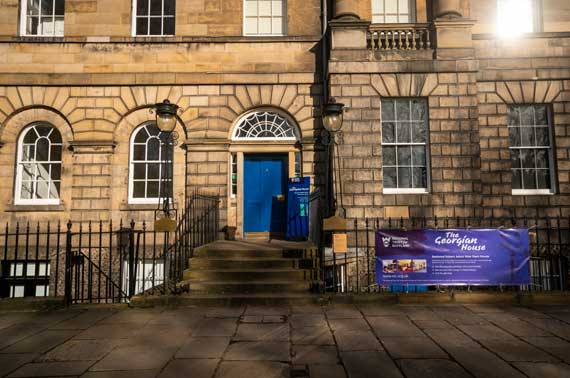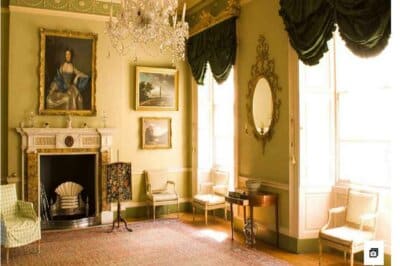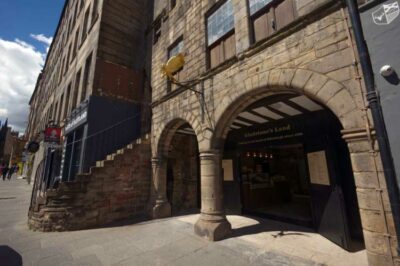
The Georgian House, a National Trust for Scotland property, is located at number 7 Charlotte Square in Edinburgh’s New Town.
Next door, at number 6, is Bute House the official residence of the First Minister of Scotland.
Today the National Trust for Scotland (NTS) manage the building allowing a fascinating snapshot of life in eighteenth century Edinburgh.
It’s a popular destination for visitors interested in learning more about Scottish history, architecture and culture.
Georgian House: designed by Robert Adam
Scottish architect Robert Adam designed the Georgian House for Argyll born John Lamont, the 18th Chief of the Clan Lamont who bought the building in 1796 for £1,800.
Adam is widely regarded as one of the most prominent architects of his time, and his work had a significant impact on the development of the neoclassical style in Britain.
Robert was the son of architect William Adam, head of a prominent family that included James and John Adam who were both architects.
The building is a fine example of the neoclassical style that was popular in the late 18th century. Its façade is made of ashlar stone and features ornate detailing, such as a pedimented doorway, pilasters, and cornices.
Today it’s still regarded as one of Adam’s finest urban works, certainly the most complete.
Scottish Enlightenment
The late 18th century was a significant period in Edinburgh’s history.
It was a time of great cultural, intellectual, and political change, and although these changes also happened in other Scottish cities, Edinburgh became a hub for many of these developments.
This momentous period in Scotland’s history became known as the Scottish Enlightenment.
Charlotte Square
Charlotte Square remains one of the most desirable and fashionable areas in Edinburgh.
It was built as part of the wider James Craig inspired project to provide the city’s elite with a more attractive place to live, one removed from the cramped squalor of the Old Town.
Craig’s plan for Edinburgh’s New Town involved a grid-like pattern of streets and squares, with grand public buildings and private residences lining the streets.
The design included two large squares – St Andrew’s Square and Charlotte Square – to be joined by George Street which was, quite simply ‘the principal street’.
Today, the New Town of Edinburgh is recognised as one of the finest examples of Georgian architecture in the world, and Robert Adam’s contributions to its design continue to be celebrated and studied by architects and historians alike.
Visit the Georgian House
Step inside the Georgian House and you enter the world of the house’s first resident John Lamont.
In the words of the National Trust for Scotland, the Georgian House…
“faithfully recreates the lifestyle of a wealthy family, as well as giving a fascinating insight of the social and economic conditions of the time.”
NTS
Lamont died in 1816 and the house passed to his son John who promptly sold it to Catherine Farquharson of Invercauld.
Other owners included Lord Neaves who, with his large family, moved in during 1845. Neaves was one of Scotland’s most experienced criminal lawyers and later appointed a Lord of Justiciary.
Moving forward, the Rev. Alexander Whyte became the fourth owner in 1889. During a busy career, he was the Moderator of the Free Church General Assembly and Principal of the University of Edinburgh New College.
The 4th Marquess of Bute followed Whyte in 1881, becoming the fifth owner of the Georgian House.
Although there is a considerable ‘ backstory’ to the purchase, The National Trust for Scotland bought the property in 1996. It first opened to the public in 1975.
What to see in the Georgian House
On show in the lavishly furnished house are fine collections of period furniture, silver and china. The walls are adorned with paintings by Sir Henry Raeburn, Alexander Nasmyth and other well-known artists.

The art collection includes portraits, landscapes, and still-life works that provide a rich and diverse look at the art of the Georgian era.
hands-on activities
A range of hands-on activities is available for visitors – adults and children. This includes the opportunity to dress in replica 18th century costumes.
Life below stairs
Life below stairs was less comfortable for the servants who toiled for long hours to ensure the smooth running of the household. Today you can enter their world and explore the kitchen, scullery and wine cellar.
As part of the experience, there are guided tours of the house, which are led by knowledgeable and enthusiastic guides.
The tours provide a wealth of information about the house’s history, architecture, and furnishings, as well as the people who lived and worked there.
Visitors can also explore the house at their own pace, using a self-guided audio tour that provides additional information about the various rooms and artworks on display.
Special events
In addition to its regular tours, the Georgian House also offers a range of special events and activities throughout the year.
These include lectures, workshops, and family-friendly activities such as craft sessions and storytelling events.
The house is also available for private hire, making it a unique and memorable venue for weddings, corporate events, and other special occasions.
Other National Trust for Scotland properties
The Georgian House is just one of many historic properties managed by the National Trust for Scotland.
NTS is an organisation dedicated to preserving and promoting Scotland’s rich cultural heritage.

It manages a wide range of properties, including castles, gardens, and museums. Its mission is to ensure that these important sites are protected for future generations to enjoy.
This article on Truly Edinburgh looks at some of the other NTS properties in Edinburgh and nearby.
In addition to its property management work, the National Trust for Scotland is also involved in a range of conservation and education initiatives.
These include conservation projects that aim to protect Scotland’s natural heritage, as well as education programs that aim to inspire young people to engage with Scotland’s history and culture.
The Georgian House, Edinburgh: suggestions for further research and reading
- Legard, J., 2023. Restoring the ‘Georgian House’: Architecture, Politics, and Identity in 1970s Edinburgh. Angles. New Perspectives on the Anglophone World, (16).
- Covington, D.P., 1977. Edinburgh, the Georgian New Town: A Conservation Project 1967–77. Journal of Interior Design Education and Research, 3(2), pp.67-80.
- Borsay, P., 2016. The Georgian house: the making of a heritage icon. In Valuing Historic Environments (pp. 157-178). Routledge.
- Knox, P.L., 1984. Edinburgh. Cities, 1(4), pp.328-334.
Further information
For further information on admission times and help planning your visit, go to the HTS website.